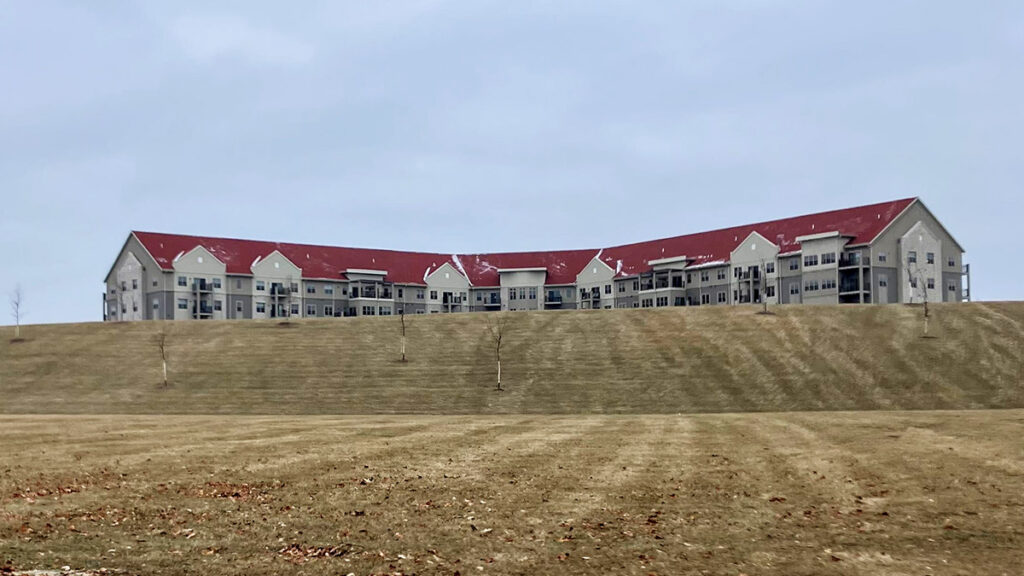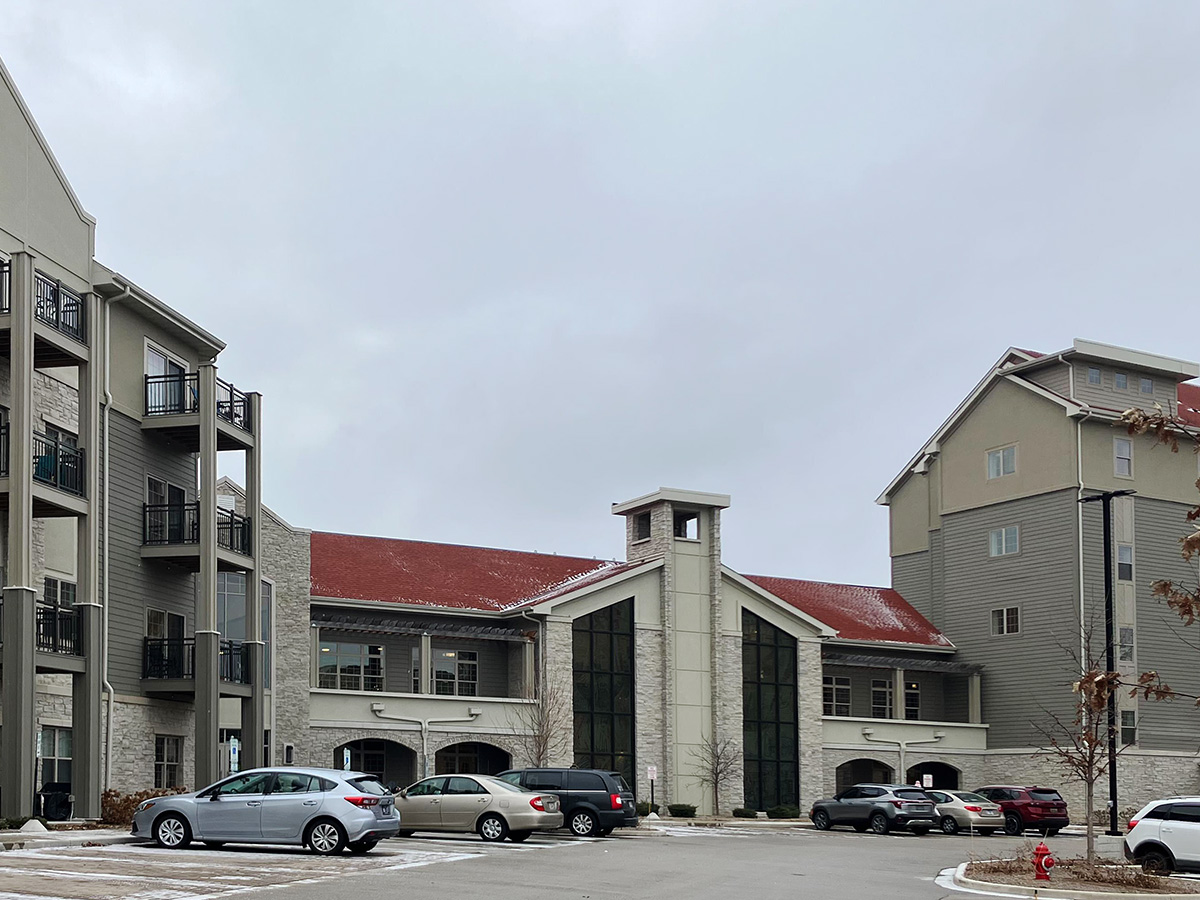On a weekday morning at Trinity Woods, a young mother drops her toddler off at the daycare connected to her apartment and heads across campus to class. Later that day, the toddler will be read to in a “book nook” by a retired School Sister of Notre Dame, whose assisted living apartment is also connected to the daycare center.
That evening, the mother and child will join other mothers and children, retired sisters and senior citizens in Trinity Woods’ communal dining room. The menu includes fresh, seasonal produce from Clare Gardens, a local farm affiliated with the residence. The farm provides produce to other area retirement communities also.
Trinity Woods is an intergenerational housing community located on the Mount Mary University campus in northern Milwaukee since December 2021. Students who are single mothers, their children, retired School Sisters of Notre Dame and senior citizens live side-by-side in a mixture of 24 student apartments, 52 assisted living apartments and 90 independent living apartments. There is a daycare center on-site with capacity for 100 children, and all areas are connected by a central “town center” with a library, dining hall and other communal spaces.
Additionally, a local high school sends four students every week to work with and care for residents in assisted living. Often these students go on to develop friendships with the residents and pursue certified nursing assistant training.
Studies show that intergenerational relationships are good for all ages. Children develop better language abilities, increased empathy and increased academic performance. Parents and young adults experience less stress, and have better educational and economic outcomes. Older people show reduced falls and frailty, better cognitive health outcomes and less social isolation and loneliness when they are connected to younger people.
Door County has a child care and elder care worker shortage that is reflective of what is happening nationally, as well as a lack of affordable housing. Intergenerational housing is one possible model that could help address these issues, according to people involved in intergenerational housing elsewhere and people working on these issues in Door County.
For the sisters, single mothers and seniors of Trinity Woods, some of the impact of these societal problems are mitigated by their intergenerational living situation, according to facility representatives.
There is not a lot of hard data available showing the specific benefits of intergenerational living, according to Sheri Steinig, the director of strategic initiatives and communications for Generations United. However, if people are in the same setting they have a better chance of building an intergenerational relationship than if they are in age-segregated housing, she said.
Generations United is a national nonprofit that works to improve the lives of people of all ages through intergenerational collaboration, public policies and programs. The organization released a strategic plan for promoting intentional intergenerational living in October 2024. The first action item in the “blueprint” is to gather more quantifiable evidence of the benefits of intergenerational living, Steinig said.
Some benefits may be obvious. “If you just look at all cultures, they have these traditions of storytelling and passing down knowledge from older to younger people,” Steinig said. “It’s just such an inherent part of being human.”

Though modern medicine is extending our lifespans, isolating people by age is not a healthy way to live, she added, and many older people are wanting a more vibrant and diverse community rather than being surrounded only by other aging, frail people.
Trinity Woods started as an “organic conversation” between the sisters, Mount Mary and Trinity Senior Services (formerly Milwaukee Catholic Home), according to Michelle Lammers. Lammers is vice president of community outreach and marketing for Trinity Senior Services, the management company who oversees the intergenerational community.
The School Sisters of Notre Dame founded Mount Mary 100 years ago. The sisters worked in partnership with the university and Trinity Senior Services when their numbers began dwindling and they no longer needed all the space in their Elm Grove convent.
The idea to include living space for student single mothers came about because of challenges faced by that population. Single mothers make up 20 percent of Mount Mary’s student body, Lammers said.
Rent for a two-bedroom student apartment in Madonna Hall, the wing for single mothers and their families, is $1,200 per month. It is student housing, so financial aid is available for residents.
Trinity Woods’ assisted living rates average about $5,000 per month, which is in line with other local assisted living costs, and the independent living apartments start around $2,500.
Local potential
Door County has an even larger population of senior citizens than most places–the average age here is about 53 versus a national average of 38.5 years.
Between the sizable elderly population, a lack of affordable housing, and a shortage of care workers for children and older adults, Door County could be an ideal place for intergenerational living to take hold, according to Cynthia Germain.
Germain is the founder and CEO of Do Good Door County, a nonprofit working to “enhance, enrich and respect the aging experience in Door County,” according to its mission. One of the primary aims of Do Good is to make Door County more livable for people of all ages and to look at ways to allow people to “age in place,” staying in their community or home successfully as they grow older.
Socialization is a huge factor in what makes it possible for someone to age in place, according to Germain, and Do Good is working on surveys in 2025 to find out how social isolation is impacting local seniors and what stakeholders can do to improve outcomes.
While intergenerational living is not necessarily a magic bullet, Germain said, it would go a long way toward solving issues like social isolation, affordable housing and care worker shortages.
Intergenerational living is not a new idea in Door County either, she said. Three years ago, the Door County Economic Development Corporation hatched an idea to operate a modular home factory, where students would work with mentors in the construction industry to build the modular or tiny homes, gaining skills and increasing affordable housing locally.
Julie Schmelzer, the director of business development at DCEDC at the time, was interested in creating intergenerational modular home neighborhoods as part of the project, according to Germain.
Unfortunately, the project never took off, she said, as DCEDC did not get the grants it needed to fund it. But the will is there, she added.
That will can go a long way, according to Steinig, who said in her experience there are usually a few people who have the commitment and tenacity to get a project off the ground. That makes sustainability important, she added, and looking through an “intergenerational lens” can help keep projects viable.
The concept is simple, she said, and requires looking at a cross section of everything that makes a community livable–transportation, housing, public space, accessibility and more–and asking the question “how can this serve multiple ages?”
An intergenerational lens can also help communities start small, by taking resources, spaces and programs that are already in existence and making them points of intergenerational connection.
“How can you integrate this work into daily life?” Steinig said. “When you’re looking at whatever issue you’re thinking about, what might be the solution that we could engage older adults as volunteers, or younger people?”
Existing spaces like libraries, playgrounds, senior centers and community centers can be made more conducive to intergenerational use, Steinig explained, and that is a relatively easy and inexpensive way to encourage connection between all ages.
Until now, models of intergenerational living usually have been targeted toward specific groups. As an example, Trinity Woods is focused on student single mothers and aging Catholic sisters. And there are several examples, nationally, of intergenerational housing and neighborhoods focused on families impacted by the foster care system.
“There’s a sense of these being somewhat boutique initiatives,” Steinig said, which is one reason Generations United held a symposium last year.
The organization invited leaders and experts in the intergenerational housing field to bring concepts together and produce a blueprint for different models to take hold.
Intergenerational living concepts and ideas vary and there are lots of options besides building brand new multi-family residences like Trinity Woods. Tiny homes, accessory dwelling units, co-housing plans, and combined senior and childcare facilities are just some examples of intergenerational living models.
Limitations to some of these ideas range from affordability and funding to working within local zoning and building codes. Sturgeon Bay’s planning commission approved the first accessory dwelling unit, or ADU, in the city in October 2024. The city code defines an ADU as a “smaller, secondary dwelling unit on the same lot as a principal dwelling.”
Dwellings such as these often are referred to as “mother-in-law apartments.” There are opportunities within this model for an older person to live alongside a family or younger adults and provide mutual support and care, Steinig said.
Sturgeon Bay zoning ordinances allow for ADUs, and though the concept has been gaining popularity in relation to housing shortages, property owners in the city have not been pursuing this option, Sturgeon Bay City Planner and Zoning Administrator Stephanie Servia said in a meeting in November 2024.
That could be a result of restrictions in the city’s current zoning code as well as building codes and a general lack of public awareness, Servia said.
Sturgeon Bay is pursuing ways to simplify the zoning ordinances, according to the planning commission’s November 2024 meeting minutes.
Funding any building is difficult, but depending on the community, there are federal housing opportunities that support some initiatives, said Steinig. Family and community foundations, local housing organizations, and county governments are all examples of stakeholders that can leverage resources as well.
As far as building codes, they can be a hindrance, especially to large multi-family buildings like Trinity Woods, according to Mariah Goode, former director of the Door County Land Use Services Department. Goode is also a volunteer for the DCEDC attainable housing committee, for the Door County Housing Partnership and for the Workforce Housing Lending Corporation and has been involved in local affordable housing initiatives for almost two decades.
Current building code for Wisconsin requires multi-family units to have sprinkler systems, for instance, and unless the building is in a community with a municipal water system, that is a very costly situation, Goode said. Sister Bay and Sturgeon Bay are the only places in Door County with municipal water systems.
Zoning and building codes are not set in stone, however, and can be changed with the will of the local people, Goode added.
Health and safety are additional concerns raised when talking about intergenerational living, Steinig said. Since the Covid pandemic, many programs that brought together children and the elderly have ceased, she said, but possibilities of spreading illness can be mitigated through common sense hygiene practices and isolation when people are sick.
As far as safety, background checks and references can help ensure that adults in contact with children are safe, she said.
One thing Door County has a lot of, Germain said, are large homes inhabited by aging residents, who no longer need all the space and might struggle to keep up with home maintenance and regular errands or chores. Co-housing agreements–in which a young person, seasonal worker or family who needs an affordable living situation trades room and board for assisting the homeowner with maintenance and other tasks–could work very well here, she said.
Assessing the needs, resources and demographics of an area to determine how intergenerational living can be created, tailored and sustained is the first step a community can take, according to Steinig.
Correction: A previous version of this story incorrectly stated Julie Schmelzer’s job title from when she worked at the Door County Economic Development Corporation. She was the organization’s director of business development, not its president. The story also incorrectly stated the starting rent for independent living apartments at Trinity Woods; it is $2,500, not $3,500. The story has been corrected.

